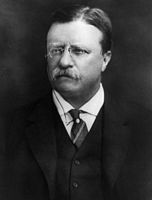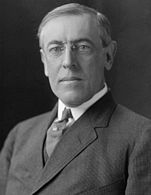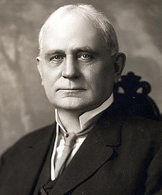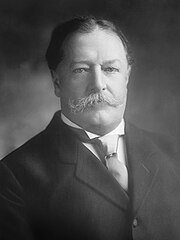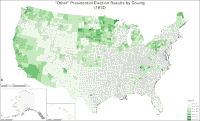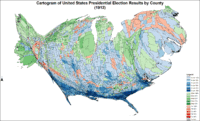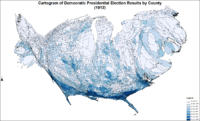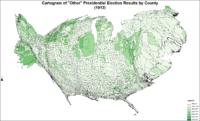用戶:Robmarotiz/1912年美國總統選舉
| 本草稿尚未完成,內容未必可信。 本草稿未來可能會被移動成為正式內容。 來源搜尋:「"1912年美国总统选举"」——Google:網頁、新聞、學術、圖書、圖片;百度:網頁、新聞、學術、圖片;知網工具書;JSTOR;維基百科圖書館 本用戶頁由Elli(貢獻·日誌)於3年前最後編輯。 |
| 此用戶頁目前正依照en:1912 United States presidential election上的內容進行翻譯。 (2020年2月25日) |
| |||||||||||||||||||||||||||||||||||||||||||||||||||||||||||||
共計531張選舉人票 | |||||||||||||||||||||||||||||||||||||||||||||||||||||||||||||
|---|---|---|---|---|---|---|---|---|---|---|---|---|---|---|---|---|---|---|---|---|---|---|---|---|---|---|---|---|---|---|---|---|---|---|---|---|---|---|---|---|---|---|---|---|---|---|---|---|---|---|---|---|---|---|---|---|---|---|---|---|---|
| 投票率 | 58.8%[1] ▼ 6.6 pp | ||||||||||||||||||||||||||||||||||||||||||||||||||||||||||||
| |||||||||||||||||||||||||||||||||||||||||||||||||||||||||||||
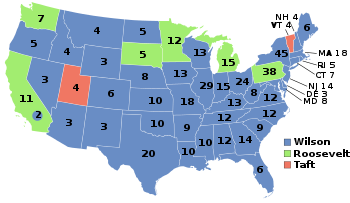 總統選舉結果地圖。藍色代表威爾遜/馬歇爾贏得的州,淺綠色代表羅斯福/約翰遜贏得的州,紅色代表塔夫脫/巴特勒贏得的州。數字代表各州擁有的選舉人票數量。 | |||||||||||||||||||||||||||||||||||||||||||||||||||||||||||||
| |||||||||||||||||||||||||||||||||||||||||||||||||||||||||||||
1912年美國總統選舉是第三十二屆美國總統選舉。選舉每四年舉辦一次,這一次舉辦於1912年11月5日星期二。來自民主黨的新澤西州長伍德羅·威爾遜擊敗了來自共和黨的現任總統威廉·霍華德·塔夫脫,當選美國總統。前總統西奧多·羅斯福作為進步黨(即公鹿黨)候選人參與了本次大選,同樣也被威爾遜擊敗。本次大選是美國最後一次非民主黨或共和黨黨籍的候選人進入前二名的大選,標誌着現代美國政治的兩個政黨取得首要地位。
羅斯福曾作為共和黨人,任1901年-1909年的美國總統。在他的支持下,塔夫脫在1908年被共和黨提名為總統候選人。然而,塔夫脫在當選總統後,卻做出了一些令羅斯福不悅的行為。羅斯福在1912年共和黨全國大會上與塔夫脫競爭候選人之位,但塔夫脫和他的保守派盟友險勝。於是,羅斯福率領他的進步派盟友另起爐灶,創立了一個第三黨參加大選。這個第三黨便是進步黨。進步黨成立不久後,羅斯福舉辦了一場競選演說,演說中途有記者來提問,羅斯福便回答道:「我感覺自己就像頭公鹿一樣頑強!」,從此進步黨便得名「公鹿黨」。[2]在民主黨這邊,威爾遜受到威廉·詹寧斯·布萊恩等民主党進步派的支持,在第46輪投票中戰勝了眾議院議長錢普·克拉克等候選人,成為民主黨總統候選人。同時,社會黨再一次提名了多年來的領袖尤金·V·德布斯。
1912年大選的競爭主要在三個人——威爾遜、羅斯福和塔夫脫——之間展開,他們中的任何一個人都可能勝選。羅斯福推出了「新民族主義」綱領,要求推行社會保險計劃。實行八小時工作制,並建立起聯邦政府在經濟調節中的牢固地位。威爾遜推出了「新自由」綱領,要求推行關稅改革和銀行業改革,並設立新的反托拉斯法。塔夫脫深知自己不太可能獲勝,所以他根據自己的「進步保守主義」綱領,發起了一場溫和的競選活動。德布斯宣稱另外三個候選人都受到了信託基金的支援,他希望自己的社會主義政策能夠激起對自身的支持。
威爾遜成功利用了共和黨的分裂:他不僅贏得了40個州,還贏下了大部分的選舉人票(531票中的435票)。他是1892年以來,第一個勝選成為總統的民主黨人,也是美國內戰到第一次世界大戰爆發之間唯二的民主黨總統中的一個。羅斯福贏得了88張選舉人票,而塔夫脫只贏得了佛蒙特州和猶他州的8張選舉人票。威爾遜贏得了41.8%的普選票,羅斯福贏得了27%,塔夫脫贏得了23%,德布斯贏得了6%。
背景[編輯]
來自共和黨的總統西奧多·羅斯福為了對美國人民履行自己不尋求第二個完整任期的承諾,拒絕在1908年美國總統選舉中競選連任。羅斯福的第一個總統任期(1901年-1905年)繼承自被刺殺的前總統威廉·麥金萊,因此,這一任期並不完整;他到了第二個任期(1905年-1909年)才真正任滿了4年。第二任期結束的時候,羅斯福指定國務卿威廉·霍華德·塔夫脫擔任他的接班人,之後在大選中,塔夫脫擊敗了民主黨候選人威廉·詹寧斯·布萊恩,勝選總統。
塔夫脫在自己的任期中逐漸與羅斯福產生了分歧,後來,兩人分別成了共和黨兩個派系的領袖:進步派(由羅斯福領導)和保守派(由塔夫脫領導)。進步派贊成限制婦女及兒童就業,提倡環境保護,且更加同情工會,還贊成舉辦普選選舉聯邦和各州的法官,反對由總統和州長任命法官。保守派支持對進口商品徵收高關稅,以鼓勵消費者購買美國製造的產品(大部分進步派也支持這一點),他們更加青睞商界領袖而非工會,且反對舉辦普選選舉法官。
到了1910年,兩派之間的矛盾已不可調和,導致羅斯福和塔夫脫拋棄友誼,互相敵對。共和黨在1910年的中期選舉中失利,使得黨的分裂繼續擴大。塔夫脫在1909年廢棄了羅斯福的反托拉斯法,[3]並轉而支持佩恩-奧爾德里奇關稅法案,[4]又在1910年開除了時任國家森林局局長的著名環保主義者吉福德·平肖,這兩件事令他在進步派內的聲望完全崩潰。[5]
提名[編輯]
民主黨的提名[編輯]
| 1912年民主黨候選人名單 | |||||||||||||||||||||||||||||
| 伍德羅·威爾遜 | 托馬斯·R·馬歇爾 | ||||||||||||||||||||||||||||
|---|---|---|---|---|---|---|---|---|---|---|---|---|---|---|---|---|---|---|---|---|---|---|---|---|---|---|---|---|---|
| 總統候選人 | 副總統候選人 | ||||||||||||||||||||||||||||
 |
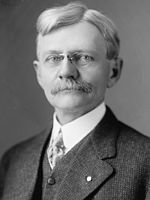 | ||||||||||||||||||||||||||||
| 第三十四任 新澤西州州長 (1911年–1913年) |
第二十七任 印第安納州州長 (1909年–1913年) | ||||||||||||||||||||||||||||
民主黨候選人:
- 新澤西州州長伍德羅·威爾遜
- 密蘇里州眾議院議長錢普·克拉克
- 俄亥俄州州長賈德森·哈蒙
- 阿拉巴馬州眾議院多數黨領袖奧斯卡·安德伍德
- 馬薩諸塞州州長尤金·福斯
- 印第安納州州長托馬斯·R·馬歇爾
- 康涅狄格州州長西米恩·埃本·鮑德溫
候選人畫像[編輯]
民主黨全國大會於6月25日-7月2日舉辦於馬里蘭州巴爾的摩,是20世紀中最令人難忘的一場總統提名大會。最初的領先者是密蘇里州的眾議院議長錢普·克拉克,克拉克在投票初期也確實得到了最多的代表票。不過,克拉克並未贏得獲提名所需的二分之三的多數票。然而,紐約市強大而又腐敗的民主黨政治機器坦慕尼協會也宣佈了對克拉克的支持,這就對克拉克的獲提名機會造成了不良影響:前三次大選中民主黨的總統候選人兼黨內進步派領袖威廉·詹寧斯·布萊恩作為「華爾街」的候選人,開始反對克拉克,並轉而支持新澤西州長伍德羅·威爾遜。威爾遜被認為是個溫和的改革者,當時,他在每一輪投票中都僅次於克拉克,幾乎放棄了勝選的希望,差點就要讓支持他的代表們投票給其他人了。布萊恩成功率領起許多代表支持威爾遜,於是威爾遜逐漸增強了實力,而對克拉克的支持不斷減少。最後在第46輪投票中,威爾遜成功獲提。
印第安納州州長托馬斯·R·馬歇爾在後來幾輪投票中令印第安納州的代表投票給威爾遜。他最後也被提名為威爾遜的競選搭檔。
| (1-24) | 總統候選人投票 | ||||||||||||||||||||||||
|---|---|---|---|---|---|---|---|---|---|---|---|---|---|---|---|---|---|---|---|---|---|---|---|---|---|
| 第一輪 | 第二輪 | 第三輪 | 第四輪 | 第五輪 | 第六輪 | 第七輪 | 第八輪 | 第九輪 | 第十輪 | 第十一輪 | 第十二輪 | 第十三輪 | 第十四輪 | 第十五輪 | 第十六輪 | 第十七輪 | 第十八輪 | 第十九輪 | 第二十輪 | 第二十一輪 | 第二十二輪 | 第二十三論 | 第二十四輪 | ||
| 伍德羅·威爾遜 | 324 | 339.75 | 345 | 349.5 | 351 | 354 | 352.5 | 351.5 | 352.5 | 350.5 | 354.5 | 354 | 356 | 361 | 362.5 | 362.5 | 362.5 | 361 | 358 | 388.5 | 395.5 | 396.5 | 399 | 402.5 | |
| 錢普·克拉克 | 440.5 | 446.5 | 441 | 443 | 443 | 445 | 449.5 | 448.5 | 452 | 556 | 554 | 547.5 | 554.5 | 553 | 552 | 551 | 545 | 535 | 532 | 512 | 508 | 500.5 | 497.5 | 496 | |
| 賈德森·哈蒙 | 148 | 141 | 140.5 | 136.5 | 141.5 | 135 | 129.5 | 130 | 127 | 31 | 29 | 29 | 29 | 29 | 29 | 29 | 29 | 29 | 29 | 29 | 29 | 0 | 0 | 0 | |
| 奧斯卡·安德伍德 | 117.5 | 111.25 | 114.5 | 112 | 119.5 | 121 | 123.5 | 123 | 122.5 | 117.5 | 118.5 | 123 | 115.5 | 111 | 110.5 | 112.5 | 112.5 | 125 | 130 | 121.5 | 118.5 | 115 | 114.5 | 115.5 | |
| 尤金·福斯 | 0 | 0 | 0 | 0 | 0 | 0 | 0 | 0 | 0 | 0 | 0 | 0 | 2 | 0 | 0 | 0 | 0 | 0 | 1 | 2 | 5 | 43 | 45 | 43 | |
| 托馬斯·R·馬歇爾 | 31 | 31 | 31 | 31 | 31 | 31 | 31 | 31 | 31 | 31 | 30 | 30 | 30 | 30 | 30 | 30 | 30 | 30 | 30 | 30 | 30 | 30 | 30 | 30 | |
| 西米恩·埃本·鮑德溫 | 22 | 14 | 14 | 14 | 0 | 0 | 0 | 0 | 0 | 0 | 0 | 0 | 0 | 0 | 0 | 0 | 0 | 0 | 0 | 0 | 0 | 0 | 0 | 0 | |
| 威廉·詹寧斯·布萊恩 | 1 | 2 | 1 | 0 | 0 | 1 | 1 | 1 | 1 | 1 | 1 | 1 | 1 | 2 | 2 | 1 | 1 | 1 | 7 | 1 | 1 | 1 | 1 | 1 | |
| 約翰·W·克恩 | 0 | 0 | 1 | 2 | 2 | 1 | 1 | 1 | 1 | 1 | 1 | 1 | 0 | 2 | 2 | 2 | 4.5 | 3.5 | 1 | 1 | 1 | 1 | 0 | 0 | |
| 奧利·默里·詹姆斯 | 0 | 0 | 0 | 0 | 0 | 0 | 0 | 1 | 0 | 0 | 0 | 0 | 0 | 0 | 0 | 0 | 0 | 0 | 0 | 3 | 0 | 0 | 0 | 0 | |
| 威廉·祖爾策 | 2 | 2 | 0 | 0 | 0 | 0 | 0 | 0 | 0 | 0 | 0 | 0 | 0 | 0 | 0 | 0 | 0 | 0 | 0 | 0 | 0 | 0 | 0 | 0 | |
| 威廉·傑伊·蓋納 | 0 | 0 | 0 | 0 | 0 | 0 | 0 | 1 | 1 | 0 | 0 | 0 | 0 | 0 | 0 | 0 | 0 | 0 | 0 | 0 | 0 | 1 | 1 | 0 | |
| J·漢密爾頓·劉易斯 | 0 | 0 | 0 | 0 | 0 | 0 | 0 | 0 | 0 | 0 | 0 | 0 | 0 | 0 | 0 | 0 | 0 | 0 | 0 | 0 | 0 | 0 | 0 | 0 | |
| 空白票 | 2 | 0.5 | 0 | 0 | 0 | 0 | 0 | 0 | 0 | 0 | 0 | 2.5 | 0 | 0 | 0 | 0 | 3.5 | 3.5 | 0 | 0 | 0 | 0 | 0 | 0 | |
| (25-46) | 總統候選人投票 | ||||||||||||||||||||||
|---|---|---|---|---|---|---|---|---|---|---|---|---|---|---|---|---|---|---|---|---|---|---|---|
| 第二十五輪 | 第二十六輪 | 第二十七輪 | 第二十八輪 | 第二十九輪 | 第三十輪 | 第三十一輪 | 第三十二輪 | 第三十三輪 | 第三十四輪 | 第三十五輪 | 第三十六輪 | 第三十七輪 | 第三十八輪 | 第三十九輪 | 第四十輪 | 第四十一輪 | 第四十二輪 | 第四十三輪 | 第四十四輪 | 第四十五輪 | 第四十六輪 | 一致通過 | |
| 伍德羅·威爾遜 | 405 | 407.5 | 406.5 | 437.5 | 436 | 460 | 475.5 | 477.5 | 477.5 | 479.5 | 494.5 | 496.5 | 496.5 | 498.5 | 501.5 | 501.5 | 499.5 | 494 | 602 | 629 | 633 | 990 | 1,088 |
| 錢普·克拉克 | 469 | 463.5 | 469 | 468.5 | 468.5 | 455 | 446.5 | 446.5 | 447.5 | 447.5 | 433.5 | 434.5 | 432.5 | 425 | 422 | 423 | 424 | 430 | 329 | 306 | 306 | 84 | |
| 賈德森·哈蒙 | 29 | 29 | 29 | 29 | 29 | 19 | 17 | 14 | 29 | 29 | 29 | 29 | 29 | 29 | 29 | 28 | 27 | 27 | 28 | 27 | 25 | 12 | |
| 奧斯卡·安德伍德 | 108 | 112.5 | 112 | 112.5 | 112 | 121.5 | 116.5 | 119.5 | 103.5 | 101.5 | 101.5 | 98.5 | 100.5 | 106 | 106 | 106 | 106 | 104 | 98.5 | 99 | 97 | 0 | |
| 尤金·福斯 | 43 | 43 | 38 | 38 | 38 | 30 | 30 | 28 | 28 | 28 | 28 | 28 | 28 | 28 | 28 | 28 | 28 | 28 | 27 | 27 | 27 | 0 | |
| 托馬斯·R·馬歇爾 | 30 | 30 | 30 | 0 | 0 | 0 | 0 | 0 | 0 | 0 | 0 | 0 | 0 | 0 | 0 | 0 | 0 | 0 | 0 | 0 | 0 | 0 | |
| 西米恩·埃本·鮑德溫 | 0 | 0 | 0 | 0 | 0 | 0 | 0 | 0 | 0 | 0 | 0 | 0 | 0 | 0 | 0 | 0 | 0 | 0 | 0 | 0 | 0 | 0 | |
| 威廉·詹寧斯·布萊恩 | 1 | 1 | 1 | 1 | 0 | 0 | 0 | 0 | 0 | 0 | 0 | 0 | 0 | 0 | 0 | 0 | 1 | 0.5 | 1 | 0 | 0 | 0 | |
| 約翰·W·克恩 | 0 | 0 | 0 | 1 | 4 | 2 | 2 | 2 | 2 | 2 | 1 | 1 | 1 | 1 | 1 | 1 | 1 | 1 | 1 | 0 | 0 | 0 | |
| 奧利·默里·詹姆斯 | 3 | 0 | 0 | 0 | 0 | 0 | 0 | 0 | 0 | 0 | 0 | 0 | 0 | 0 | 0 | 0 | 0 | 1 | 0 | 0 | 0 | 0 | |
| 威廉·祖爾策 | 0 | 0 | 0 | 0 | 0 | 0 | 0 | 0 | 0 | 0 | 0 | 0 | 0 | 0 | 0 | 0 | 0 | 0 | 0 | 0 | 0 | 0 | |
| 威廉·傑伊·蓋納 | 0 | 0 | 0 | 0 | 0 | 0 | 0 | 0 | 0 | 0 | 0 | 0 | 0 | 0 | 0 | 0 | 1 | 1 | 0 | 0 | 0 | 0 | |
| J·漢密爾頓·劉易斯 | 0 | 0 | 0 | 0 | 0 | 0 | 0 | 0 | 0 | 0 | 0 | 0 | 0 | 0 | 0 | 0 | 0 | 1 | 0 | 0 | 0 | 0 | |
| 空白票 | 0 | 1.5 | 2.5 | 0.5 | 0.5 | 0.5 | 0.5 | 0.5 | 0.5 | 0.5 | 0.5 | 0.5 | 0.5 | 0.5 | 0.5 | 0.5 | 0.5 | 0.5 | 1.5 | 0 | 0 | 2 | |
| 副總統候選人投票 | |||
| 第一輪 | 第二輪 | 一致通過 | |
|---|---|---|---|
| 托馬斯·R·馬歇爾 | 389 | 644.5 | 1,088 |
| 約翰·伯克 | 304.67 | 386.33 | |
| 喬治·厄爾·張伯倫 | 157 | 12.5 | |
| 埃爾莫爾·W·赫斯特 | 78 | 0 | |
| 詹姆斯·H·普雷斯頓 | 58 | 0 | |
| 馬丁·約瑟夫·韋德 | 26 | 0 | |
| 威廉·F·麥庫姆斯 | 18 | 0 | |
| 約翰·尤金·奧斯本 | 8 | 0 | |
| 威廉·祖爾策 | 3 | 0 | |
| 空白票 | 46.33 | 44.67 | |
進步黨的提名[編輯]
| 1912年進步黨候選人名單 | |||||||||||||||||||||||||||||
| 西奧多·羅斯福 | 海勒姆·約翰遜 | ||||||||||||||||||||||||||||
|---|---|---|---|---|---|---|---|---|---|---|---|---|---|---|---|---|---|---|---|---|---|---|---|---|---|---|---|---|---|
| 總統候選人 | 副總統候選人 | ||||||||||||||||||||||||||||
 |
 | ||||||||||||||||||||||||||||
| 第二十六任 美國總統 (1901年–1909年) |
第二十三任 加利福尼亞州州長 (1911年–1917年) | ||||||||||||||||||||||||||||
進步黨候選人:
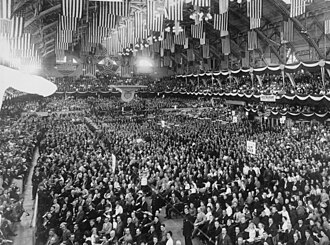
共和党進步派在芝加哥重新開了一場會議,決定組建一個全國的進步主義政黨。當年晚些時候,新生的進步黨提名羅斯福為總統候選人,加利福尼亞州州長海勒姆·約翰遜為副總統候選人。羅斯福在回答記者的提問時,說感覺自己像一頭「公鹿」一樣強壯,從此進步黨便得名「公鹿黨」。進步黨承諾強化聯邦法規,並保護普通民眾的福利。
進步黨受到了出版商弗蘭克·芒西和黨執行秘書喬治·沃爾布里奇·珀金斯的資助。珀金斯是銀行家約翰·皮爾龐特·摩根的國際收割機公司的一名員工,他阻止過一份反托拉斯法案的通過,令以為羅斯福是個真正的反托拉斯先鋒的改革者們震驚。進步黨的代表們唱着黨歌「信徒精兵歌」來到了大會現場。羅斯福在他那著名的受命演說中,將即將來臨的大選比作哈米吉多頓之戰,稱進步黨將「為天主而戰」。然而,美國許多親共和黨的報紙批評羅斯福是個自我中心主義者,說他參加大選只是為了破壞塔夫脫勝選的機會並滿足自己的虛榮心。
共和黨的提名[編輯]
| 1912年共和黨候選人名單 | |||||||||||||||||||||||||||||
| 威廉·霍華德·塔夫脫 | 詹姆斯·S·舍曼 | ||||||||||||||||||||||||||||
|---|---|---|---|---|---|---|---|---|---|---|---|---|---|---|---|---|---|---|---|---|---|---|---|---|---|---|---|---|---|
| 總統候選人 | 副總統候選人 | ||||||||||||||||||||||||||||
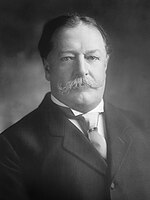 |
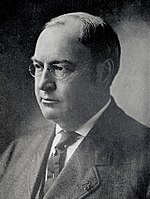 | ||||||||||||||||||||||||||||
| 第二十七任 美國總統 (1909年–1913年) |
第二十七任 美國副總統 (1909年–1912年) | ||||||||||||||||||||||||||||
共和黨候選人:
Candidates gallery[編輯]

For the first time, significant numbers of delegates to the national conventions were elected in presidential preference primaries. Progressive Republicans advocated primary elections as a way of breaking the control of political parties by bosses. Altogether, twelve states held Republican primaries. Senator Robert M. La Follette won two of the first four primaries (in North Dakota and Wisconsin), but beginning with his runaway victory in Illinois on April 9, Roosevelt won nine of the last ten presidential primaries (in order, Illinois, Pennsylvania, Nebraska, Oregon, Maryland, California, Ohio, New Jersey, and South Dakota), losing only Massachusetts to Taft.[6] As a sign of his great popularity, Roosevelt even carried Taft's home state of Ohio.
The Republican Convention convened in Chicago from June 18 to 22. Taft, however, had begun to gather delegates earlier, and the delegates chosen in the primaries were a minority. He had the support of the bulk of the party organizations in the Southern states; these states had voted solidly Democratic in every presidential election since 1880, and Roosevelt objected that they were given one-quarter of the delegates when they would contribute nothing to a Republican victory (as it turned out, delegates from the former Confederate states supported Taft by a 5 to 1 margin). When the convention gathered, Roosevelt challenged the credentials of nearly half of the delegates.[來源請求] By that time, however, it was too late. The delegates chose Elihu Root — once Roosevelt's top ally — to serve as chairman of the convention. Afterwards, the delegates seated Taft delegations in Alabama, Arizona, and California on tight votes of 597-472, 564-497, and 542-529, respectively. After losing California, where Roosevelt had won the primary, the progressive delegates gave up hope. They voted "present" on most succeeding roll calls. Not since the 1872 election had there been a major schism in the Republican Party. Now, with the Democrats holding about 45% of the national vote, any schism would be fatal. Roosevelt's only hope at the convention was to form a "stop-Taft" alliance with La Follette, but Roosevelt had alienated La Follette, and the alliance could not form.
Unable to tolerate the personal humiliation he suffered at the hands of Taft and the Old Guard, and refusing to entertain the possibility of a compromise candidate, Roosevelt struck back hard. On the evening of June 22, 1912, Roosevelt asked his supporters to leave the convention, maintaining that Taft had allowed fraudulent seating of delegates to capture the presidential nomination from progressive forces within the party. Thus, with the support of convention chairman Root, Taft's supporters outvoted Roosevelt's men, and the convention renominated the incumbent ticket of Taft and James S. Sherman. Sherman became the first sitting Vice President to be nominated for re-election since John C. Calhoun in 1828.
| Presidential Ballot[7][8][9] | |
| William Taft | 561 |
|---|---|
| Theodore Roosevelt | 107 |
| Robert La Follette | 41 |
| Albert B. Cummins | 17 |
| Charles Evans Hughes | 2 |
| Present, not voting | 344 |
| Absent | 6 |
| Vice Presidential Ballot | |
| James S. Sherman | 596 |
|---|---|
| William Borah | 21 |
| Charles Edward Merriam | 20 |
| Herbert S. Hadley | 14 |
| Albert J. Beveridge | 2 |
Socialist Party nomination[編輯]
| Socialist Party Ticket, 1912 | |||||||||||||||||||||||||||||
| Eugene V. Debs | Emil Seidel | ||||||||||||||||||||||||||||
|---|---|---|---|---|---|---|---|---|---|---|---|---|---|---|---|---|---|---|---|---|---|---|---|---|---|---|---|---|---|
| for President | for Vice President | ||||||||||||||||||||||||||||
 |
 | ||||||||||||||||||||||||||||
| Former Indiana State Senator (1885–1887) |
36th Mayor of Milwaukee (1910–1912) | ||||||||||||||||||||||||||||
Socialist candidates:
- Eugene V. Debs, former State Representative from Indiana
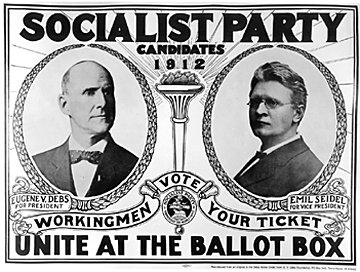
The Socialist Party of America was a highly factionalized coalition of local parties based in industrial cities and usually was rooted in ethnic communities, especially German and Finnish. It also had some support in old Populist rural and mining areas in the West, especially Oklahoma. By 1912, the party claimed more than a thousand locally elected officials in 33 states and 160 cities, especially the Midwest. Eugene V. Debs had run for president in 1900, 1904, and 1908, primarily to encourage the local effort, and he did so again in 1912 and from prison in 1920.[10]
The conservatives, led by Victor L. Berger from Milwaukee, promoted progressive causes of efficiency and an end to corruption, nicknamed "gas and water socialism." Their opponents were the radicals who wanted to overthrow capitalism, tried to infiltrate labor unions, and sought to cooperate with the Industrial Workers of the World ("the Wobblies"). With few exceptions, the party had weak or nonexistent links to local labor unions. Immigration was an issue—the radicals saw immigrants as fodder for the war with capitalism, while conservatives complained that they lowered wage rates and absorbed too many city resources. Many of these issues had been debated at the First National Congress of the Socialist Party in 1910, and they were debated again at the national convention in Indianapolis in 1912. At the latter, the radicals won an early test by seating Bill Haywood on the Executive Committee, sending encouragement to western "Wobblies", and passed a resolution seeming to favor industrial unionism. The conservatives counterattacked by amending the party constitution to expel any socialists who favored industrial sabotage or syndicalism (that is, the IWW), and who refused to participate in American elections. They adopted a conservative platform calling for cooperative organization of prisons, a national bureau of health, abolition of the Senate and the presidential veto. Debs did not attend; he saw his mission as keeping the disparate units together in the hope that someday a common goal would be found.
General election[編輯]
Campaign[編輯]
The 1912 presidential campaign was bitterly contested. Vice President James S. Sherman died in office on October 30, 1912, less than a week before the election, leaving President Taft without a running mate. (Nicholas M. Butler was designated to receive electoral votes that would have been cast for Sherman.) With the Republican Party divided, Wilson captured the presidency handily on November 5.[來源請求]

While Roosevelt was campaigning in Milwaukee on October 14, 1912, a saloonkeeper from New York, John Flammang Schrank, shot him, but the bullet lodged in his chest only after penetrating both his steel eyeglass case and a 50-page single-folded copy of the speech titled "Progressive Cause Greater Than Any Individual", he was to deliver, carried in his jacket pocket. Schrank was immediately disarmed, captured and might have been lynched had Roosevelt not shouted for Schrank to remain unharmed.[11] Roosevelt assured the crowd he was all right, then ordered police to take charge of Schrank and to make sure no violence was done to him.[12] Roosevelt, as an experienced hunter and anatomist, correctly concluded that since he was not coughing blood, the bullet had not reached his lung, and he declined suggestions to go to the hospital immediately. Instead, he delivered his scheduled speech with blood seeping into his shirt.[13] He spoke for 90 minutes before completing his speech and accepting medical attention. His opening comments to the gathered crowd were, "Ladies and gentlemen, I don't know whether you fully understand that I have just been shot, but it takes more than that to kill a Bull Moose."[14][15] Afterwards, probes and an x-ray showed that the bullet had lodged in Roosevelt's chest muscle, but did not penetrate the pleura. Doctors concluded that it would be less dangerous to leave it in place than to attempt to remove it, and Roosevelt carried the bullet with him for the rest of his life.[16][17] In later years, when asked about the bullet inside him, Roosevelt would say, "I do not mind it any more than if it were in my waistcoat pocket."[18]
Both Taft and Democratic nominee Woodrow Wilson suspended their own campaigning until Roosevelt recovered and resumed his. When asked if the shooting would affect his election campaign, he said to the reporter "I'm fit as a bull moose", which inspired the party's emblem.[19] He spent two weeks recuperating before returning to the campaign trail.
The election of 1912 is considered the high tide of progressive politics. Had either Roosevelt or Taft stayed out of the race, a Republican victory would have been assured.[來源請求]
The Socialists had little money; Debs' campaign cost only $66,000, mostly for 3.5 million leaflets and travel to rallies organized by local groups. His biggest event was a speech to 15,000 supporters in New York City. The crowd sang "La Marseillaise" and "The Internationale" as Emil Seidel, the vice- presidential candidate, boasted, "Only a year ago workingmen were throwing decayed vegetables and rotten eggs at us but now all is changed... Eggs are too high. There is a great giant growing up in this country that will someday take over the affairs of this nation. He is a little giant now but he is growing fast. The name of this little giant is socialism." Debs said that only the socialists represented labor. He condemned "Injunction Bill Taft" and ridiculed Roosevelt as "a charlatan, mountebank, and fraud, and his Progressive promises and pledges as the mouthings of a low and utterly unprincipled self seeker and demagogue." Debs insisted that the Democrats, Progressives, and Republicans alike were financed by the trusts. Party newspapers spread the word—there were five English-language and eight foreign-language dailies along with 262 English and 36 foreign-language weeklies. The labor union movement, however, largely rejected Debs and supported Wilson.[來源請求]

Roosevelt conducted a vigorous national campaign for the Progressive Party, denouncing the way the Republican nomination had been "stolen". He bundled together his reforms under the rubric of "The New Nationalism" and stumped the country for a strong federal role in regulating the economy and chastising bad corporations. Wilson supported a policy called "The New Freedom". This policy was based mostly on individualism instead of a strong government. Taft campaigned quietly, and spoke of the need for judges to be more powerful than elected officials. The departure of the more progressive Republicans left the conservative Republicans even more firmly in control of their party until 1916, when many progressives returned. Much of the Republican effort was designed to discredit Roosevelt as a dangerous radical, but this had little effect.[來源請求]
Tariffs and Republican Party split[編輯]
Before the ratification of the Sixteenth Amendment to the United States Constitution (1913), the funding of the United States government heavily relied upon tariffs. Tariffs are a direct taxation of raw materials and manufactured goods with regard to trade. This issue was key in fracturing the Republican Party. Early in his term, President Taft had promised to stand for a lower tariff bill. Protectionism was major policy of the business oriented Republican Party.[20]
After Congressional deliberation, the Payne-Aldrich Act (1909) was passed and signed by President Taft. The Payne-Aldrich Act would not satisfy the growing economic sectionalism of the country; the Northwest and South wanted tariff reductions on manufactured goods, as well as more raw materials to be added to the 'free-list' (non-taxed goods)[21] The new tariff policy would increase duties; going against President Taft's promises, it further alienated the progressive wing of the Republican Party. President Taft's inability to satisfy both wings of his party would create a political opening for his predecessor, Theodore Roosevelt, to make a run for the presidency. Theodore Roosevelt would rally progressives with speeches to pressure the political establishment. In regards to the existing tariff policy, Theodore Roosevelt would vouch for "...an expert tariff commission, wholly removed from the possibility of political pressure or of improper business influence.".[22]
Results[編輯]

The impact of the third-party vote is indicated by the fact that few states were carried by a majority of the popular vote. Taft carried two states (Utah and Vermont), Roosevelt six, and Wilson forty. Taft carried no state with a popular majority, Roosevelt one (South Dakota, where there was no Republican ticket), and Wilson eleven, all of them states of the former Confederacy. More than two-thirds of Wilson's total vote was cast in the 37 states that he did not carry by majority vote.[23]
Wilson's vote, 6,296,919, was less than William Jennings Bryan totaled in any one of his campaigns, and over 100,000 less than Bryan received in 1908, when Bryan won only 162 electoral votes.[23] Wilson fell behind Bryan's results in most of the country, and notably so in Pennsylvania, Ohio, Indiana, Illinois, Michigan, Nebraska, Kansas, South Carolina, Kentucky, and Arkansas. In only two sections was Wilson's vote greater than the greatest Bryan vote: New England and the Pacific.[24] Wilson led the poll in 1,969 counties, but he received a majority of the vote in only 1,237 counties, less than Bryan had had in any of his campaigns.[24] Taft had a majority in only 35, and "Other(s)" in only 305. These small figures clearly reveal the result of the division of the normal Republican vote, as does the fact that in a plurality of counties (1,396) no candidate obtained a majority.[25] Taft had a lead over the field in only 232 counties. In addition to South Dakota and California, where there was no Taft ticket, and seven "Solid South" states in which he carried no county, Taft also carried no counties in Maine, New Jersey, Minnesota, Nevada and Arizona.[24] Nine counties did not record any votes due to either black disenfranchisement or being inhabited only by Native Americans who would not gain full citizenship for twelve more years.
The 772 counties not carried by Wilson or by Taft were distributed in 38 states, most of them in Pennsylvania (48), Illinois (33), Michigan (68), Minnesota (75), Iowa (49), South Dakota (54), Nebraska (32), Kansas (51), Washington (38), and California (44), and almost without exception were carried by Roosevelt. Debs carried four counties in Minnesota (Lake and Beltrami), North Dakota (Burke County), and Kansas (Crawford County), the only counties ever to vote socialist in a presidential election.
This was the first time in 60 years (since 1852) that Iowa, Maine, New Hampshire, Ohio, and Rhode Island voted for a Democrat, and the first time in history that Massachusetts voted for a Democratic candidate. This was the last election in which the Democrats won Maine until 1964, the last in which the Democrats won Connecticut and Delaware until 1936, the last in which the Democrats won Illinois, Indiana, Iowa, New Jersey, New York, Oregon, West Virginia, and Wisconsin until 1932, and the last in which the Democrats won Massachusetts and Rhode Island until 1928. After the 2016 presidential election, 1912 remains the last election in which the key Indiana counties of Hamilton and Hendricks, along with Walworth County, Wisconsin, Pulaski and Laurel Counties in Kentucky and Hawkins County, Tennessee have given a plurality to the Democratic candidate.[26] In post-Civil War America, this is the only presidential election in which a third party candidate outperformed one of the candidates from the two-major parties in the general election.
The 1912 election was the first to include all 48 of the current contiguous United States.
Taft's 1912 result was the worst performance for any incumbent president seeking re-election, both in terms of electoral votes (8) and share of popular votes (23.17%). His electoral votes also represented the fewest number of electoral votes by either major parties, matched with Alf Landon's 1936 result. He was also remained the only major party nominee not finished in top two.
| 總統候選人 | 政黨 | 出身 | 普選票 | 選舉人票 |
競選夥伴 | |||
|---|---|---|---|---|---|---|---|---|
| 數目 | 比例 | 副總統候選人 | 出身 | 選舉人票 | ||||
| Woodrow Wilson | Democratic | New Jersey | 6,296,284 | 41.84% | 435 | Thomas R. Marshall | Indiana | 435 |
| Theodore Roosevelt | Progressive | New York | 4,122,721 | 27.40% | 88 | Hiram W. Johnson | California | 88 |
| William Howard Taft (Incumbent) | Republican | Ohio | 3,486,242 | 23.17% | 8 | Nicholas Murray Butler | New York | 8 |
| Eugene V. Debs | Socialist | Indiana | 901,551 | 5.99% | 0 | Emil Seidel | Wisconsin | 0 |
| Eugene W. Chafin | Prohibition | Illinois | 208,156 | 1.38% | 0 | Aaron S. Watkins | Ohio | 0 |
| Arthur E. Reimer | Socialist Labor | Massachusetts | 29,324 | 0.19% | 0 | August Gillhaus | New York | 0 |
| 其他 | 4,556 | 0.03% | — | 其他 | — | |||
| 總計 | 15,048,834 | 100% | 531 | 531 | ||||
| 獲勝需要 | 266 | 266 | ||||||
Source (Popular Vote): Leip, David. 1912 Presidential Election Results. Dave Leip's Atlas of U.S. Presidential Elections (July 28, 2005).
Source (Electoral Vote): Electoral College Box Scores 1789–1996. Official website of the National Archives. (July 31, 2005).
Geography of results[編輯]

-
Results by county, shaded according to winning candidate's percentage of the vote
Cartographic gallery[編輯]
-
Map of presidential election results by county
-
Map of Democratic presidential election results by county
-
Map of "other" presidential election results by county
-
Map of Republican presidential election results by county
-
Cartogram (county sizes based on total votes recorded) of presidential election results by county
-
Cartogram (county sizes based on total votes recorded) of Democratic presidential election results by county
-
Cartogram (county sizes based on total votes recorded) of "other" presidential election results by county
-
Cartogram (county sizes based on total votes recorded) of Republican presidential election results by county
Results by state[編輯]
| States won by Wilson/Marshall |
| States won by Roosevelt/Johnson |
| States won by Taft/Butler |
| Woodrow Wilson Democratic |
Theodore Roosevelt Progressive |
William H. Taft Republican |
Eugene V. Debs Socialist |
Eugene Chafin Prohibition |
Arthur Reimer Socialist Labor |
Margin | State Total | ||||||||||||||||
|---|---|---|---|---|---|---|---|---|---|---|---|---|---|---|---|---|---|---|---|---|---|---|---|
| State | electoral votes |
# | % | electoral votes |
# | % | electoral votes |
# | % | electoral votes |
# | % | electoral votes |
# | % | electoral votes |
# | % | electoral votes |
# | % | # | |
| Alabama | 12 | 82,438 | 69.89 | 12 | 22,680 | 19.23 | - | 9,807 | 8.31 | - | 3,029 | 2.57 | - | - | - | - | - | - | - | 59,758 | 50.66 | 117,959 | AL |
| Arizona | 3 | 10,324 | 43.52 | 3 | 6,949 | 29.29 | - | 3,021 | 12.74 | - | 3,163 | 13.33 | - | 265 | 1.12 | - | - | - | - | 3,375 | 14.23 | 23,722 | AZ |
| Arkansas | 9 | 68,814 | 55.01 | 9 | 21,644 | 17.30 | - | 25,585 | 20.45 | - | 8,153 | 6.52 | - | 908 | 0.73 | - | - | - | - | 43,229 | 34.55 | 125,104 | AR |
| California | 13 | 283,436 | 41.81 | 2 | 283,610 | 41.83 | 11 | 3,914 | 0.58 | - | 79,201 | 11.68 | - | 23,366 | 3.45 | - | - | - | - | -174 | -0.03 | 677,944 | CA |
| Colorado | 6 | 114,232 | 42.80 | 6 | 72,306 | 27.09 | - | 58,386 | 21.88 | - | 16,418 | 6.15 | - | 5,063 | 1.90 | - | 475 | 0.18 | - | 41,926 | 15.71 | 266,880 | CO |
| Connecticut | 7 | 74,561 | 39.16 | 7 | 34,129 | 17.92 | - | 68,324 | 35.88 | - | 10,056 | 5.28 | - | 2,068 | 1.09 | - | 1,260 | 0.66 | - | 6,237 | 3.28 | 190,404 | CT |
| Delaware | 3 | 22,631 | 46.48 | 3 | 8,886 | 18.25 | - | 15,998 | 32.85 | - | 556 | 1.14 | - | 623 | 1.28 | - | - | - | - | 6,633 | 13.62 | 48,694 | DE |
| Florida | 6 | 35,343 | 69.52 | 6 | 4,555 | 8.96 | - | 4,279 | 8.42 | - | 4,806 | 9.45 | - | 1,854 | 3.65 | - | - | - | - | 30,537 | 60.07 | 50,837 | FL |
| Georgia | 14 | 93,087 | 76.63 | 14 | 21,985 | 18.10 | - | 5,191 | 4.27 | - | 1,058 | 0.87 | - | 149 | 0.12 | - | - | - | - | 71,102 | 58.53 | 121,470 | GA |
| Idaho | 4 | 33,921 | 32.08 | 4 | 25,527 | 24.14 | - | 32,810 | 31.02 | - | 11,960 | 11.31 | - | 1,536 | 1.45 | - | - | - | - | 1,111 | 1.05 | 105,754 | ID |
| Illinois | 29 | 405,048 | 35.34 | 29 | 386,478 | 33.72 | - | 253,593 | 22.13 | - | 81,278 | 7.09 | - | 15,710 | 1.37 | - | 4,066 | 0.35 | - | 18,570 | 1.62 | 146,173 | IL |
| Indiana | 15 | 281,890 | 43.07 | 15 | 162,007 | 24.75 | - | 151,267 | 23.11 | - | 36,931 | 5.64 | - | 19,249 | 2.94 | - | 3,130 | 0.48 | - | 119,883 | 18.32 | 654,474 | IN |
| Iowa | 13 | 185,325 | 37.64 | 13 | 161,819 | 32.87 | - | 119,805 | 24.33 | - | 16,967 | 3.45 | - | 8,440 | 1.71 | - | - | - | - | 23,506 | 4.77 | 492,356 | IA |
| Kansas | 10 | 143,663 | 39.30 | 10 | 120,210 | 32.88 | - | 74,845 | 20.47 | - | 26,779 | 7.33 | - | - | - | - | - | - | - | 23,453 | 6.42 | 365,560 | KS |
| Kentucky | 13 | 219,484 | 48.48 | 13 | 101,766 | 22.48 | - | 115,510 | 25.52 | - | 11,646 | 2.57 | - | 3,253 | 0.72 | - | 1,055 | 0.23 | - | 103,974 | 22.97 | 452,714 | KY |
| Louisiana | 10 | 60,871 | 76.81 | 10 | 9,283 | 11.71 | - | 3,833 | 4.84 | - | 5,261 | 6.64 | - | - | - | - | - | - | - | 51,588 | 65.10 | 79,248 | LA |
| Maine | 6 | 51,113 | 39.43 | 6 | 48,495 | 37.41 | - | 26,545 | 20.48 | - | 2,541 | 1.96 | - | 946 | 0.73 | - | - | - | - | 2,618 | 2.02 | 129,640 | ME |
| Maryland | 8 | 112,674 | 48.57 | 8 | 57,789 | 24.91 | - | 54,956 | 23.69 | - | 3,996 | 1.72 | - | 2,244 | 0.97 | - | 322 | 0.14 | - | 54,885 | 23.66 | 231,981 | MD |
| Massachusetts | 18 | 173,408 | 35.53 | 18 | 142,228 | 29.14 | - | 155,948 | 31.95 | - | 12,616 | 2.58 | - | 2,754 | 0.56 | - | 1,102 | 0.23 | - | 17,460 | 3.58 | 488,057 | MA |
| Michigan | 15 | 150,751 | 27.36 | - | 214,584 | 38.95 | 15 | 152,244 | 27.63 | - | 23,211 | 4.21 | - | 8,934 | 1.62 | - | 1,252 | 0.23 | - | -62,340 | -11.31 | 550,976 | MI |
| Minnesota | 12 | 106,426 | 31.84 | - | 125,856 | 37.66 | 12 | 64,334 | 19.25 | - | 27,505 | 8.23 | - | 7,886 | 2.36 | - | 2,212 | 0.66 | - | -19,430 | -5.81 | 334,219 | MN |
| Mississippi | 10 | 57,324 | 88.90 | 10 | 3,549 | 5.50 | - | 1,560 | 2.42 | - | 2,050 | 3.18 | - | - | - | - | - | - | - | 53,775 | 83.39 | 64,483 | MS |
| Missouri | 18 | 330,746 | 47.35 | 18 | 124,375 | 17.80 | - | 207,821 | 29.75 | - | 28,466 | 4.07 | - | 5,380 | 0.77 | - | 1,778 | 0.25 | - | 122,925 | 17.60 | 698,566 | MO |
| Montana | 4 | 27,941 | 35.00 | 4 | 22,456 | 28.13 | - | 18,512 | 23.19 | - | 10,885 | 13.64 | - | 32 | 0.04 | - | - | - | - | 5,485 | 6.87 | 79,826 | MT |
| Nebraska | 8 | 109,008 | 43.69 | 8 | 72,681 | 29.13 | - | 54,226 | 21.74 | - | 10,185 | 4.08 | - | 3,383 | 1.36 | - | - | - | - | 36,327 | 14.56 | 249,483 | NE |
| Nevada | 3 | 7,986 | 39.70 | 3 | 5,620 | 27.94 | - | 3,196 | 15.89 | - | 3,313 | 16.47 | - | - | - | - | - | - | - | 2,366 | 11.76 | 20,115 | NV |
| New Hampshire | 4 | 34,724 | 39.48 | 4 | 17,794 | 20.23 | - | 32,927 | 37.43 | - | 1,981 | 2.25 | - | 535 | 0.61 | - | - | - | - | 1,797 | 2.04 | 87,961 | NH |
| New Jersey | 14 | 178,289 | 41.20 | 14 | 145,410 | 33.60 | - | 88,835 | 20.53 | - | 15,948 | 3.69 | - | 2,936 | 0.68 | - | 1,321 | 0.31 | - | 32,879 | 7.60 | 432,739 | NJ |
| New Mexico | 3 | 20,437 | 41.39 | 3 | 8,347 | 16.90 | - | 17,733 | 35.91 | - | 2,859 | 5.79 | - | - | - | - | - | - | - | 2,704 | 5.48 | 49,376 | NM |
| New York | 45 | 655,573 | 41.27 | 45 | 390,093 | 24.56 | - | 455,487 | 28.68 | - | 63,434 | 3.99 | - | 19,455 | 1.22 | - | 4,273 | 0.27 | - | 200,086 | 12.60 | 1,588,315 | NY |
| North Carolina | 12 | 144,407 | 59.24 | 12 | 69,135 | 28.36 | - | 29,129 | 11.95 | - | 987 | 0.40 | - | 118 | 0.05 | - | - | - | - | 75,272 | 30.88 | 243,776 | NC |
| North Dakota | 5 | 29,555 | 34.14 | 5 | 25,726 | 29.71 | - | 23,090 | 26.67 | - | 6,966 | 8.05 | - | 1,243 | 1.44 | - | - | - | - | 3,829 | 4.42 | 86,580 | ND |
| Ohio | 24 | 424,834 | 40.96 | 24 | 229,807 | 22.16 | - | 278,168 | 26.82 | - | 90,144 | 8.69 | - | 11,511 | 1.11 | - | 2,630 | 0.25 | - | 146,666 | 14.14 | 1,037,094 | OH |
| Oklahoma | 10 | 119,156 | 46.95 | 10 | - | - | - | 90,786 | 35.77 | - | 41,674 | 16.42 | - | 2,185 | 0.86 | - | - | - | - | 28,370 | 11.18 | 253,801 | OK |
| Oregon | 5 | 47,064 | 34.34 | 5 | 37,600 | 27.44 | - | 34,673 | 25.30 | - | 13,343 | 9.74 | - | 4,360 | 3.18 | - | - | - | - | 9,464 | 6.91 | 137,040 | OR |
| Pennsylvania | 38 | 395,637 | 32.49 | - | 444,894 | 36.53 | 38 | 273,360 | 22.45 | - | 83,614 | 6.87 | - | 19,525 | 1.60 | - | 706 | 0.06 | - | -49,257 | -4.04 | 1,217,736 | PA |
| Rhode Island | 5 | 30,412 | 39.04 | 5 | 16,878 | 21.67 | - | 27,703 | 35.56 | - | 2,049 | 2.63 | - | 616 | 0.79 | - | 236 | 0.30 | - | 2,709 | 3.48 | 77,894 | RI |
| South Carolina | 9 | 48,357 | 95.94 | 9 | 1,293 | 2.57 | - | 536 | 1.06 | - | 164 | 0.33 | - | - | - | - | - | - | - | 47,064 | 93.37 | 50,405 | SC |
| South Dakota | 5 | 48,942 | 42.07 | - | 58,811 | 50.56 | 5 | - | - | - | 4,662 | 4.01 | - | 3,910 | 3.36 | - | - | - | - | -9,869 | -8.48 | 116,325 | SD |
| Tennessee | 12 | 133,021 | 52.80 | 12 | 54,041 | 21.45 | - | 60,475 | 24.00 | - | 3,564 | 1.41 | - | 832 | 0.33 | - | - | - | - | 72,546 | 28.80 | 251,933 | TN |
| Texas | 20 | 221,589 | 72.62 | 20 | 28,853 | 9.46 | - | 26,755 | 8.77 | - | 25,743 | 8.44 | - | 1,738 | 0.57 | - | 442 | 0.14 | - | 192,736 | 63.17 | 305,120 | TX |
| Utah | 4 | 36,579 | 32.55 | - | 24,174 | 21.51 | - | 42,100 | 37.46 | 4 | 9,023 | 8.03 | - | - | - | - | 510 | 0.45 | - | -5,521 | -4.91 | 112,386 | UT |
| Vermont | 4 | 15,354 | 24.43 | - | 22,132 | 35.22 | - | 23,332 | 37.13 | 4 | 928 | 1.48 | - | 1,095 | 1.74 | - | - | - | - | -1,200 | -1.91 | 62,841 | VT |
| Virginia | 12 | 90,332 | 65.95 | 12 | 21,776 | 15.90 | - | 23,288 | 17.00 | - | 820 | 0.60 | - | 709 | 0.52 | - | 50 | 0.04 | - | 67,044 | 48.95 | 136,975 | VA |
| Washington | 7 | 86,840 | 26.90 | - | 113,698 | 35.22 | 7 | 70,445 | 21.82 | - | 40,134 | 12.43 | - | 9,810 | 3.04 | - | 1,872 | 0.58 | - | -26,858 | -8.32 | 322,799 | WA |
| West Virginia | 8 | 113,197 | 42.11 | 8 | 79,112 | 29.43 | - | 56,754 | 21.11 | - | 15,248 | 5.67 | - | 4,517 | 1.68 | - | - | - | - | 34,085 | 12.68 | 268,828 | WV |
| Wisconsin | 13 | 164,230 | 41.06 | 13 | 62,448 | 15.61 | - | 130,596 | 32.65 | - | 33,476 | 8.37 | - | 8,584 | 2.15 | - | 632 | 0.16 | - | 33,634 | 8.41 | 399,975 | WI |
| Wyoming | 3 | 15,310 | 36.20 | 3 | 9,232 | 21.83 | - | 14,560 | 34.42 | - | 2,760 | 6.53 | - | 434 | 1.03 | - | - | - | - | 750 | 1.77 | 42,296 | WY |
| TOTALS: | 531 | 6,296,284 | 41.84 | 435 | 4,122,721 | 27.40 | 88 | 3,486,242 | 23.17 | 8 | 901,551 | 5.99 | - | 208,156 | 1.38 | - | 29,324 | 0.19 | - | 2,173,563 | 14.44 | 15,048,834 | US |
Close states[編輯]
Margin of victory less than 1% (13 electoral votes):
- California, 0.03%
Margin of victory less than 5% (142 electoral votes):
- Idaho, 1.05%
- Illinois, 1.62%
- Wyoming, 1.77%
- Vermont, 1.91%
- Maine, 2.02%
- New Hampshire, 2.04%
- Connecticut, 3.28%
- Rhode Island, 3.48%
- Massachusetts, 3.58%
- Pennsylvania, 4.04%
- North Dakota, 4.42%
- Iowa, 4.77%
- Utah, 4.91%
Margin of victory between 5% and 10% (73 electoral votes):
- New Mexico, 5.48%
- Minnesota, 5.81%
- Kansas, 6.42%
- Montana, 6.87%
- Oregon, 6.91%
- New Jersey, 7.60%
- Washington, 8.32%
- Wisconsin, 8.41%
- South Dakota, 8.48%
Statistics[編輯]
Counties with Highest Percent of Vote (Democratic)
- Greenville County, South Carolina 100.00%
- Marlboro County, South Carolina 100.00%
- Hampton County, South Carolina 100.00%
- Jasper County, South Carolina 100.00%
- Reagan County, Texas 100.00%
Counties with Highest Percent of Vote (Other)
- Scott County, Tennessee 82.80%
- Campbell County, South Dakota 80.42%
- Clearwater County, Minnesota 77.35%
- Avery County, North Carolina 72.84%
- Cook County, Minnesota 72.70%
Counties with Highest Percent of Vote (Republican)
- Zapata County, Texas 80.89%
- Valencia County, New Mexico 77.25%
- Kane County, Utah 75.40%
- Clinton County, Kentucky 64.79%
- Huerfano County, Colorado 63.36%
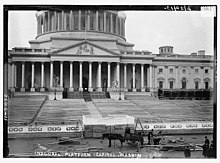
See also[編輯]
- Progressive Era
- History of the United States (1865–1918)
- 1912 United States House of Representatives elections
- 1912 and 1913 United States Senate elections
- First inauguration of Woodrow Wilson
Notes[編輯]
References[編輯]
- ^ Voter Turnout in Presidential Elections. The American Presidency Project. UC Santa Barbara.
- ^ Morris, Edmund. Colonel Roosevelt.. New York: Random House Trade Paperbacks. : 215.
- ^ Anderson (1973), p.79
- ^ Coletta, Presidency of William Howard Taft ch 3
- ^ Schweikart and Allen, p. 491.
- ^ History, Travel, Arts, Science, People, Places | Smithsonian. Smithsonianmag.com. [2016-08-18].
- ^ Taft Is Nominated On First Ballot. Santa Cruz News (Santa Cruz, CA). June 22, 1912 [January 7, 2018].
- ^ Taft Wins With 561. The Courier (Harrisburg, PA). June 23, 1912 [January 7, 2018].
- ^ Pietrusza, David. 1920: The Year of the Six Presidents. New York: Carroll & Graf. 2007. ISBN 0-7867-1622-3.
- ^ Ira Kipnis, The American Socialist Movement, 1897–1912 1952.
- ^ The Bull Moose and related media. [March 8, 2010]. (原始內容存檔於March 8, 2010).
to make sure that no violence was done
- ^ Remey, Oliver E.; Cochems, Henry F.; Bloodgood, Wheeler P. The Attempted Assassination of Ex-President Theodore Roosevelt. Milwaukee, Wisconsin: The Progressive Publishing Company. 1912: 192.
- ^ Medical History of American Presidents. Doctor Zebra. [September 14, 2010].
- ^ Excerpt, Detroit Free Press, History buff.
- ^ It Takes More Than That to Kill a Bull Moose: The Leader and The Cause. Theodore Roosevelt Association. [October 14, 2015].
- ^ Roosevelt Timeline. Theodore Roosevelt. [September 14, 2010].
- ^ Timeline of Theodore Roosevelt's Life by the Theodore Roosevelt Association at www.theodoreroosevelt.org
- ^ Donavan, p. 119
- ^ Archived copy. [2010-11-09]. (原始內容存檔於2015-09-19).
- ^ NEW YORK TIMES. (1909, September 19). MR. TAFT'S DECISION. Retrieved February 22, 2017, from https://timesmachine.nytimes.com/timesmachine/1909/09/19/106721681.pdf
- ^ Fisk, G. M. (1910). The Payne-Aldrich Tariff. Political Science Quarterly,25(1), 35-39. doi:10.2307/2141008
- ^ Theodore Roosevelt Association. "The New Nationalism." The New Nationalism - Theodore Roosevelt Association. N.p., n.d. Web. 17 Apr. 2017.
- ^ 23.0 23.1 The Presidential Vote, 1896–1932, Edgar E. Robinson, pg. 14
- ^ 24.0 24.1 24.2 The Presidential Vote, 1896–1932, Edgar E. Robinson, pg. 15
- ^ The Presidential Vote, 1896–1932, Edgar E. Robinson, pg. 17
- ^ Sullivan, Robert David; 『How the Red and Blue Map Evolved Over the Past Century』; America Magazine in The National Catholic Review; June 29, 2016
- ^ 1912 Presidential General Election Data – National. Uselectionatlas.org. [May 4, 2013].
Further reading[編輯]
| 外部影片連結 | |
|---|---|
- Broderick, Francis L. Progressivism at risk: Electing a president in 1912 (Praeger, 1989).
- Chace, James. 1912: Wilson, Roosevelt, Taft, and Debs—The Election That Changed the Country. New York: Simon and Schuster. 2004. ISBN 0-7432-0394-1.
- Cooper, John Milton, Jr. The Warrior and the Priest: Woodrow Wilson and Theodore Roosevelt. Cambridge: Belknap Press. 1983. ISBN 0-674-94751-7.
- Cowan, Geoffrey. Let the People Rule: Theodore Roosevelt and the Birth of the Presidential Primary (2016).
- Delahaye, Claire. "The New Nationalism and Progressive Issues: The Break with Taft and the 1912 Campaign," in Serge Ricard, ed., A Companion to Theodore Roosevelt (2011) pp 452–67. online
- DeWitt, Benjamin P. The Progressive Movement: A Non-Partisan, Comprehensive Discussion of Current Tendencies in American Politics. (1915).
- Flehinger, Brett. The 1912 Election and the Power of Progressivism: A Brief History with Documents (Bedford/St. Martin's, 2003).
- Flynn, James P. "Eugene Debs and the Politics of Parrhesia." (MA thesis, U of South Carolina, 2015). online
- Gable, John A. The Bullmoose Years: Theodore Roosevelt and the Progressive Party. Port Washington, NY: Kennikat Press, 1978.
- Gould, Lewis L. Four hats in the ring: The 1912 election and the birth of modern American politics (Univ Pr of Kansas, 2008).
- Jensen, Richard. "Theodore Roosevelt" in Encyclopedia of Third Parties. (ME Sharpe, 2000). pp 702–707.
- Kipnis, Ira. The American Socialist Movement, 1897–1912. New York: Columbia University Press. 1952.
- Kraig, Robert Alexander. "The 1912 Election and the Rhetorical Foundations of the Liberal State." Rhetoric and Public Affairs (2000): 363-395. in JSTOR
- Link, Arthur S. Wilson: Volume 1, The Road to the White House. 1956.
- Milkis, Sidney M., and Daniel J. Tichenor. ""Direct Democracy" and Social Justice: The Progressive Party Campaign of 1912." Studies in American Political Development 8#2 (1994): 282-340.
- Milkis, Sidney M. Theodore Roosevelt, the Progressive Party, and the Transformation of American Democracy. Lawrence, KS: University Press of Kansas, 2009.
- Morgan, H. Wayne. Eugene V. Debs: Socialist for President. Syracuse University Press. 1962.
- Mowry, George E. Theodore Roosevelt and the Progressive Movement. Madison: Wisconsin University Press. 1946.
- Mowry, George E. The Era of Theodore Roosevelt and the Birth of Modern America. New York: Harper and Row, 1962.
- O'Mara, Margaret. Pivotal Tuesdays: Four Elections That Shaped the Twentieth Century (2015), compares 1912, 1932, 1968, 1992 in terms of social, economic, and political history
- Painter, Carl, "The Progressive Party In Indiana," Indiana Magazine of History, 16#3 (1920), pp. 173–283. In JSTOR
- Pinchot, Amos. History of the Progressive Party, 1912–1916. Introduction by Helene Maxwell Hooker. (New York University Press, 1958).
- Selmi, Patrick. "Jane Addams and the Progressive Party Campaign for President in 1912." Journal of Progressive Human Services 22.2 (2011): 160-190.
- Wilensky, Norman N. Conservatives in the Progressive Era: The Taft Republicans of 1912. Gainesville: University of Florida Press. 1965.
Primary sources[編輯]
- Pinchot, Amos. What's the Matter with America: The Meaning of the Progressive Movement and the Rise of the New Party. n.c.: Amos Pinchot, 1912.
- Roosevelt, Theodore. Bull Moose on the Stump: The 1912 Campaign Speeches of Theodore Roosevelt Ed. Lewis L. Gould. (UP of Kansas, 2008).
- Wilson, Woodrow. John Wells Davidson , 編. A Crossroads of Freedom, the 1912 Campaign Speeches. 1956.
外部連結[編輯]
- 《大英百科全書》中的條目:United States presidential election of 1912(英文)
- Presidential Election of 1912: A Resource Guide from the Library of Congress
- editorial cartoons
- Sound recording of TR speech
- Woodrow Wilson Suspends Campaign After TR Assassination Attempt Shapell Manuscript Foundation
- OurCampaigns.com overview of Republican Presidential Primaries of 1912
- 1912 popular vote by counties
- 1912 State-by-state Popular vote
- The Election of 1912
- How close was the 1912 election? — Michael Sheppard, Massachusetts Institute of Technology
- Election of 1912 in Counting the Votes
| ||||||||||||||||||||||||||||||||||||||||||||||||||||||||||||||||||||||||||||||||||||||||||||||||
Template:Socialist Party of America
| ||||||||||||||||||||||||||||||||||||||||||||||||||||

